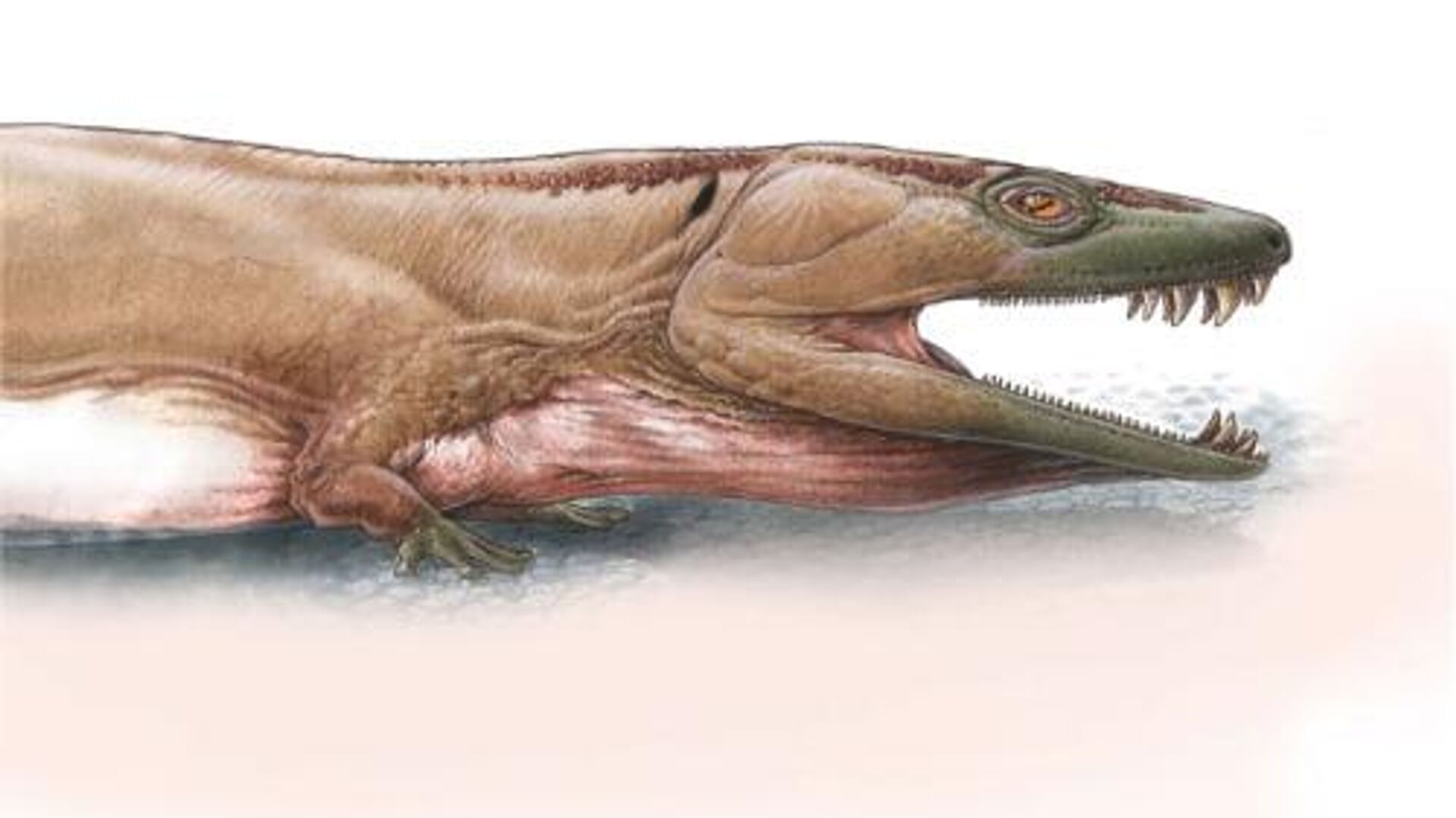https://en.sputniknews.africa/20240704/discovery-of-fossils-of-ancient-creature-in-namibia-sheds-light-on-evolution-of-land-animals-1067370441.html
Discovery of Fossils of Ancient Creature in Namibia Sheds Light on Evolution of Land Animals
Discovery of Fossils of Ancient Creature in Namibia Sheds Light on Evolution of Land Animals
Sputnik Africa
An apex predator is an animal at the top of the food chain that has no natural predators. These predators play a crucial role in maintaining the balance of... 04.07.2024, Sputnik Africa
2024-07-04T18:18+0200
2024-07-04T18:18+0200
2024-07-04T18:46+0200
sub-saharan africa
namibia
southern africa
discovery
nature
science
animals
europe
north america
https://cdn1.img.sputniknews.africa/img/07e8/07/04/1067370771_0:0:500:281_1920x0_80_0_0_0954a93f9f39e29b39d39ef0999b07c2.jpg
A 280-million-year-old salamander-like apex predator, Gaiasia jennyae, has been unearthed in Namibia, shedding light on the early evolution of land animals, a freshly minted article in the Nature Science journal revealed.Measuring about 2.5 meters with a large, toilet seat-shaped head and interlocking fangs, Gaiasia was the dominant predator in its ecosystem and one of the largest land predators of its time. It is the "largest digited stem tetrapod known at present," according to the article.Named after the Gai-As Formation and a world-renowned paleontologist Jenny Clack, the fossils found include skull fragments and a nearly complete spine, indicating a powerful bite for capturing large prey.The significance of this discovery lies in its location, as most early land animal fossils have previously been found in the ancient equatorial wetlands of what would become Europe and North America. At the time, Namibia was much further south, part of the southern supercontinent of Gondwana.While equatorial regions were becoming forested, Namibia’s cooler swamps, possibly near ice patches and glaciers, housed these large predators. This discovery reveals that such predators thrived in harsh climates, in contrast to the evolutionary paths taken by animals in warmer regions that eventually led to mammals, reptiles, and amphibians.
https://en.sputniknews.africa/20240617/is-it-possible-to-know-any-fact-about-history-of-mankind-archeologist-answers-1067077995.html
namibia
southern africa
europe
north america
Sputnik Africa
feedback@sputniknews.com
+74956456601
MIA „Rossiya Segodnya“
2024
Christina Glazkova
https://cdn1.img.sputniknews.africa/img/07e7/0b/07/1063380906_0:0:673:674_100x100_80_0_0_79628b4d0cd9f29291a57aa13bbf9e7a.jpg
Christina Glazkova
https://cdn1.img.sputniknews.africa/img/07e7/0b/07/1063380906_0:0:673:674_100x100_80_0_0_79628b4d0cd9f29291a57aa13bbf9e7a.jpg
News
en_EN
Sputnik Africa
feedback@sputniknews.com
+74956456601
MIA „Rossiya Segodnya“
Sputnik Africa
feedback@sputniknews.com
+74956456601
MIA „Rossiya Segodnya“
Christina Glazkova
https://cdn1.img.sputniknews.africa/img/07e7/0b/07/1063380906_0:0:673:674_100x100_80_0_0_79628b4d0cd9f29291a57aa13bbf9e7a.jpg
namibia, southern africa, discovery, nature, science, animals, europe, north america
namibia, southern africa, discovery, nature, science, animals, europe, north america
Discovery of Fossils of Ancient Creature in Namibia Sheds Light on Evolution of Land Animals
18:18 04.07.2024 (Updated: 18:46 04.07.2024) Christina Glazkova
Writer / Editor
An apex predator is an animal at the top of the food chain that has no natural predators. These predators play a crucial role in maintaining the balance of ecosystems by regulating the populations of other species.
A 280-million-year-old salamander-like apex predator, Gaiasia jennyae, has been unearthed in Namibia,
shedding light on the early evolution of land animals, a freshly minted
article in the Nature Science journal revealed.
Measuring about 2.5 meters with a large, toilet seat-shaped head and interlocking fangs, Gaiasia was the dominant predator in its ecosystem and one of the largest land predators of its time. It is the "largest digited stem tetrapod known at present," according to the article.
Named after the Gai-As Formation and a world-renowned paleontologist Jenny Clack, the fossils found include skull fragments and a nearly complete spine, indicating a powerful bite for capturing large prey.
The significance of this discovery lies in its location, as most early land animal fossils have previously been found in the ancient equatorial wetlands of what would become Europe and North America. At the time, Namibia was much further south, part of the southern supercontinent of Gondwana.
"Our discovery and identification of a giant stem tetrapod [...] greatly expands our understanding of the morphology, ecology, and biogeography of the initial diversification of tetrapods," the paper said.
While equatorial regions were becoming forested,
Namibia’s cooler swamps, possibly near ice patches and glaciers, housed these large predators. This discovery reveals that such predators thrived in harsh climates, in contrast to the evolutionary paths taken by animals in warmer regions that eventually led to mammals, reptiles, and amphibians.



